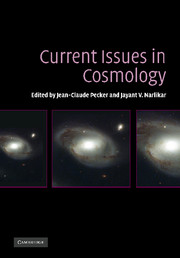Book contents
- Frontmatter
- Contents
- List of contributors
- Preface
- Part I Observational facts relating to discrete sources
- Part II Observational facts relating to background radiation
- Part III Standard cosmology
- Part IV Large-scale structure
- 9 Observations of large-scale structure
- 10 Reconstruction of large-scale peculiar velocity fields
- Part V Alternative cosmologies
- Part VI Evidence for anomalous redshifts
- Part VII Panel discussion
- Index
9 - Observations of large-scale structure
Published online by Cambridge University Press: 15 December 2009
- Frontmatter
- Contents
- List of contributors
- Preface
- Part I Observational facts relating to discrete sources
- Part II Observational facts relating to background radiation
- Part III Standard cosmology
- Part IV Large-scale structure
- 9 Observations of large-scale structure
- 10 Reconstruction of large-scale peculiar velocity fields
- Part V Alternative cosmologies
- Part VI Evidence for anomalous redshifts
- Part VII Panel discussion
- Index
Summary
Introduction
Over the past decade, the observation of the galaxy distribution at large scale has made significant advances thanks to (i) the building of fiber spectrographs with a large field of view and a high multiplex gain (Lewis et al. 2002; Burles et al. 1999, Watson et al. 1998), and (ii) the dedication of large numbers of observing nights or the use of dedicated telescopes for such projects. These observations have led to extensive maps of the distribution of matter traced by the galaxies. The three major projects aimed at mapping the “local Universe” over large solid angles are:
the 2dF Galaxy Redshift Survey, an Anglo-Australian collaboration;
the Sloan Digital Sky Survey, a US–Japanese–German collaboration;
the 6dF Galaxy Survey, another Anglo-Australian collaboration.
In the following, I review these surveys and the remarkable results that they have provided on the large-scale structure of the Universe. I also review the recent or undergoing surveys to higher depth.
The large solid angle surveys
The 2dF Galaxy Redshift Survey
The 2dF Galaxy Redshift Survey (2dFGRS) is now complete and covers ∼1 500 square degrees of the southern sky, distributed in two strip-like regions of 70 to 80° long in right ascension and∼10° and∼14° wide resp. in declination, plus∼80 single fields dispersed over the Southern Galactic Cap. The photometric catalog is based on the APM catalog (for “Automatic Plate Measuring machine” used to scan theUK Schmidt photographic plates; Maddox et al. 1990), which has been re-calibrated using CCD images. The limiting magnitude of the 2dFGRS is bJ = 19.45.
- Type
- Chapter
- Information
- Current Issues in Cosmology , pp. 111 - 122Publisher: Cambridge University PressPrint publication year: 2006



